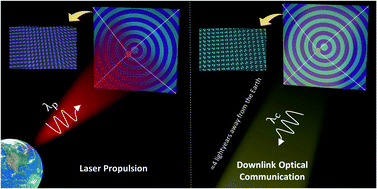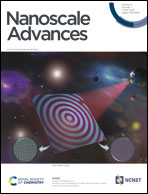Multifunctional metasails for self-stabilized beam-riding and optical communication†
Abstract
The photonic propulsion of lightsails can be used to accelerate spacecraft to relativistic velocities, providing a feasible route for the exploration of interstellar space in the human lifetime. Breakthrough Starshot is an initiative aiming to launch lightsail-driven spacecrafts accelerated to a relativistic velocity of 0.2c via radiation pressure of a high-power laser beam in order to probe the habitable zone of Alpha Centauri, located 4.2 light years away from the Earth, and transmit back the scientific data collected in the flyby mission to an Earth-based receiver. The success of such a mission requires the lightsail to provide maximal acceleration while featuring beam-riding stability under the illumination of an intense laser beam during the launch phase. Moreover, the large-area lightsail can be harnessed to improve the margin in the photon-starved downlink channel throughout the communication phase by maximizing the gain of the transmitter despite extending the acceleration period and reducing the stability margin due to the elimination of a portion of the propulsion segments. Owing to the potential of metasurfaces to serve as low-weight versatile multifunctional photonic components, metasurface-based lightsails or metasails are deemed to be ideal candidates to simultaneously address the requirements of photonic propulsion and optical communication in laser-driven deep-space probes. Here, we demonstrate the design of a multifunctional metasail for providing high acceleration and enabling the self-stabilized beam-riding of a spacecraft with a detached payload from the sail while maximizing the transmission gain in the downlink optical communication. The metasail consists of two interleaved sub-arrays of dielectric unit cells operating based on the Pancharatnam–Berry geometric phase, optimized to meet the propulsion and communication requirements, respectively. The beam-riding stability of the sail is analyzed through simulation of the motion trajectory during the acceleration phase, while taking into account the effect of the relativistic Doppler shift, and the downlink communication performance is enabled by providing the required conjugate phase by the metasail elements, resulting in beam collimation. The obtained results verify the multifunctionality of the platform and point toward the promise of metasails for extended mission applications.



 Please wait while we load your content...
Please wait while we load your content...